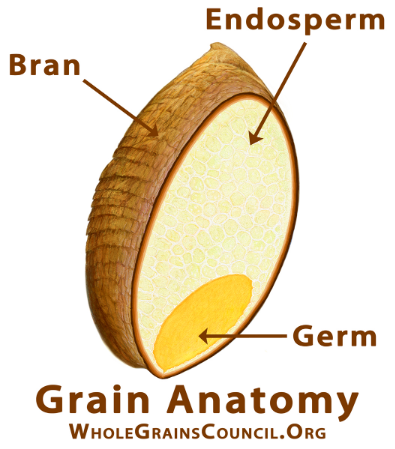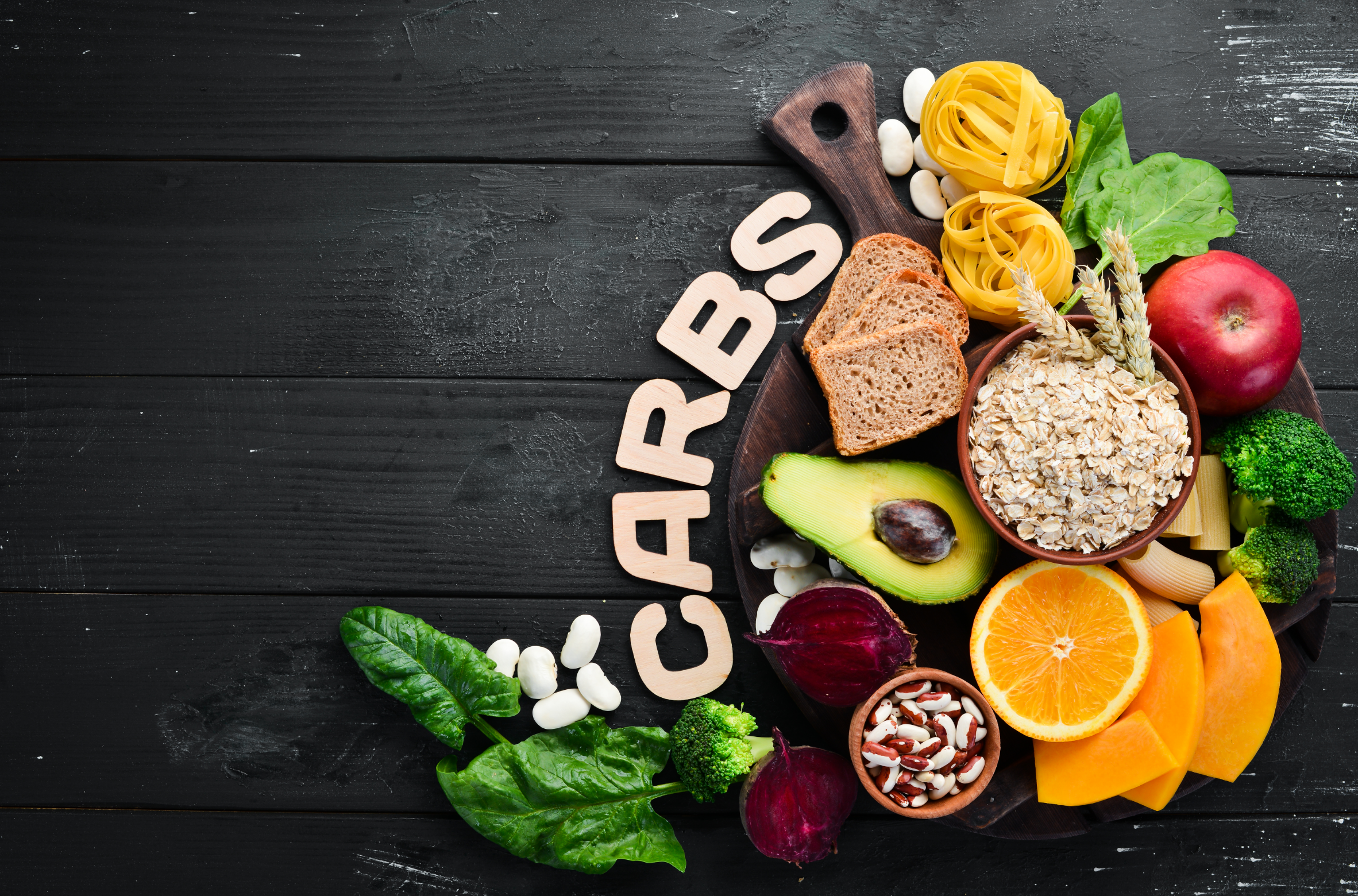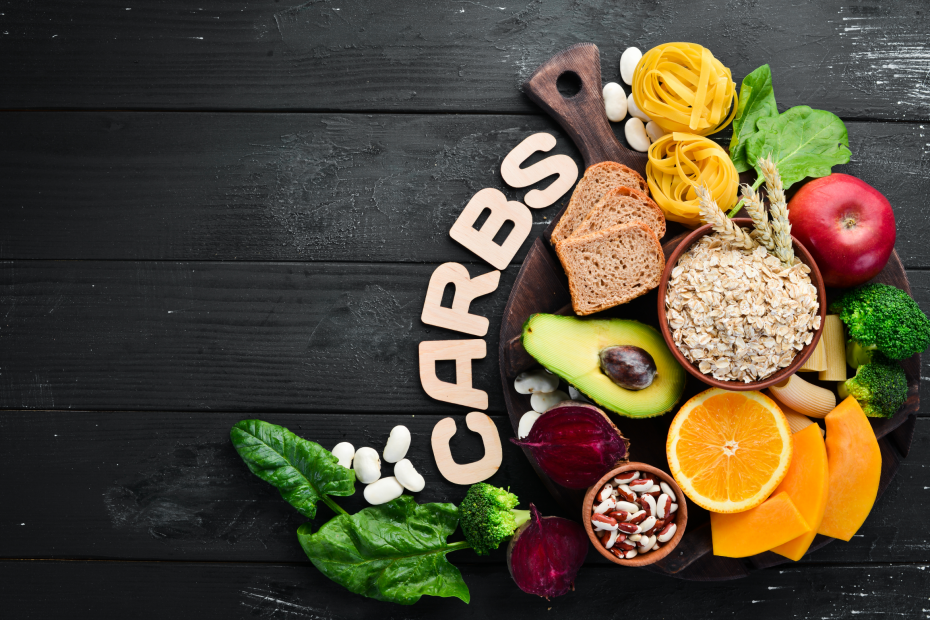Have you heard about the latest diet craze that’s sweeping the country?
Chances are that you’ve seen a headline like this lately. Honestly, there are so many diet trends it can be hard to keep track. But one thing they all seem to have in common these days is a focus on carbohydrates (“carbs”). Why is that? And do we really need to, as the expression says, “watch our carbs”?
Well, almost everything we eat contains carbohydrates. They are a large percentage of most people’s food consumption.
Carbs are also the body’s primary source of glucose , which is the energy source for all of our activities, including exercise, digestion, and—yes—even thinking!
Fun fact: The brain accounts for only around 2% of body weight, but uses around 20% of the body’s glucose-derived energy. [Source]
Our body breaks down (digests) carbohydrates for glucose, which gets shuttled where it’s needed—muscles, organs, brain—via our blood (hence the terms “blood glucose” and “blood sugar”).
A Closer Look: Blood Sugar, Diabetes, and Insulin
A high blood glucose/blood sugar level can indicate that glucose isn’t getting into cells the way it should, which happens in conditions like diabetes.
Insulin is a hormone made by the body (the pancreas, specifically) that acts like a key to “unlock” cells so glucose can get in, providing them with energy for all their functions. In diabetes, either the body doesn’t make insulin (type 1) or the body can’t make it or use it effectively (type 2).
Any glucose our cells don’t use right away gets stored in our liver and muscles in a special form called glycogen, which is accessed between meals for energy as needed. And if our liver and muscle glycogen storage becomes full, we store additional glucose as fat.
So carbs are important because they’re the main source of energy for our body to function.
But if we regularly get too many, we may start to gain weight, increasing our risk for a variety of diseases. Additionally, carbs come in different types and qualities, and these can be more healthy or less healthy for us.
This is why doctors or nutritionists may say we need to “watch our carbs”—in other words, we need to pay more attention to the quantity and quality of the carbs we eat. Let’s get started!
Carbohydrates 101
Carbohydrates are often categorized as either simple or complex, which is related to their chemical structure (how the atoms are arranged). One way to think about it is to envision simple carbohydrates as a single line of wooden blocks:

Simple carbohydrates are made of simple chemical building blocks that are broken down easily and enter the bloodstream quickly, causing a rapid rise (and fall) in blood sugar (a “spike”). They are found in foods like fruit, milk, and white sugar.
These spikes can make your blood “syrupy” and harder for your heart to pump around your body. Long term, blood sugar spikes can cause heart, kidney, eye, and nerve damage.
Sometimes simple carbohydrates are also called “simple sugars.” In this case, “sugar” has a more technical meaning than the sweetener you put in your tea or coffee. Again, it’s referring to the chemical structure, and there are more types than just white table sugar.
Fun Fact: The simple sugar in fruit is called fructose. The simple sugar in white sugar is called sucrose, and the simple sugars in milk are called glucose and galactose (together they form lactose).
To continue our analogy with building blocks, we can envision complex carbohydrates as more of a structure with levels and branches:
Complex carbohydrates are also known as starches , and are made of multiple simple carbohydrates put together in elaborate ways. These include bread, pasta, potatoes, and cereals/grains like rice, wheat, maize (corn), and barley.
Because they’re structurally more complex, starches are broken down into simple carbohydrates more slowly, providing a steadier supply of glucose.
Fiber is the undigestible part of carbohydrates. Vegetables and whole (unrefined) cereals/grains
are excellent sources of fiber, helping us feel full longer. Fiber helps slow digestion down, steadying glucose release and keeping blood sugar stable. It also forms feces (“poop”) and helps people avoid constipation by promoting regular bowel movements.
A Closer Look: Carbohydrate Structure
At the level of the atom, carbohydrates are just collections of carbon (C), hydrogen (H), and oxygen (O) atoms. The structure determines whether they are simple or complex. You can see how the structure of a simple sugar (the row of glucose molecules) is less complex than the branching structure of starch.
Quality Control
So what makes a carb “good” or “bad”? The main factor is how “whole” it is. That means how close it is to its natural state, and how free from processing.
In the case of simple carbohydrates, naturally occurring sugars—like those found in fruit and milk—are healthier than processed sugars—like those found in white sugar, soda/cola/pop, and fruit/juice drinks.
In the case of complex carbohydrates, a whole grain—such as whole wheat flour—is the whole kernel, which includes the bran, germ, and the endosperm. But a refined grain—such as white flour—has had the bran and germ removed. This gives the flour a finer texture, but it also removes valuable fiber, iron, and B vitamins. This means white flour raises blood sugar more quickly than whole-wheat flour, and can lead to spikes in blood sugar and insulin. These spikes are hard on the body and can cause damage to the heart, kidneys, nerves, and eyes.

Sometimes refined grains have ingredients like vitamins added back in, which means they have been “enriched .” But the fiber is not added back in, and your body may not be able to use the enriched vitamins as well as the original ones, which were removed during processing.
Ultimately, it’s healthier to eat foods that are “the whole package”—and as close to their natural state to begin with—rather than ones whose natural nutrition has been removed and then added back (enriched) in synthetic (man-made) forms, if at all.
Prepared Foods
Many prepared and/or packaged foods—such as sugary drinks, cookies, crackers, deli meats, and frozen meals—are highly processed. Nutritious elements have been removed to make the foods more shelf-stable or their textures and flavors more appealing with added salt, sugar, and fat, but these changes make them less healthy. People who eat a lot of processed or prepared foods tend to have more difficulty controlling their weight, their blood sugar, and even their blood pressure, which puts them at greater risk for diabetes, heart disease, and stroke, as well as other conditions.
Pro Tip: When eating out, choose brown rice instead of white rice. Choose salad instead of fries. Choose fruit instead of ice cream or another rich dessert. Sound like too much? Start with just one of these choices and try working your way up.
Sugar
As we saw above, sugar in our food comes in many forms, from the natural sugar in fruit (fructose) to added sugar in prepared foods. For sugar, as with other carbs, a good general rule is to choose natural food sources (fruit, for example) over products with added/prepared sugar (packaged cookies), and—most importantly—to limit sugar consumption overall to the extent possible.
Many people wonder whether some types are better than others. For example, is brown sugar healthier than white sugar? According to the Harvard Medical School Health Blog , sugars are essentially equivalent. There may be minor differences in vitamin content or where in the body they are metabolized, but these are not significant for health.
How Much Is Okay to Eat?
The USDA’s Dietary Guidelines for Americans recommends that we get 45% to 65% of our daily calories from carbohydrates. They suggest aiming to fill half of your meal plate with fruits and vegetables (which are mostly carbohydrates—sugars, starches, and fiber). And for the fruits, they suggest emphasizing whole fruits. Similarly, for dietary carbs that come from grains, the USDA recommends making half of them whole grains.
The Bottom Line
Whenever you feel overwhelmed by nutritional information, just remember a few key things. When you have a choice:
- Choose less-processed (“whole”) food over more-processed food
- Choose high-fiber foods over low-fiber foods
- Limit sugar
For examples of healthy meals and snacks see Getting the Right Balance and the Mediterranean Diet. For tips on eating out, see Eating Healthy While Eating Out.
Sources:
American Heart Association (carbohydrates)
Centers for Disease Control & Prevention (diabetes, insulin)
Cleveland Clinic (glycogen)
Consumer Lab (vitamin and mineral sources)
Harvard Medical School Health Blog (types of sugar)
Harvard School of Public Health (carbohydrates, blood sugar)
MD Anderson Cancer Clinic (blood sugar)
US Dept of Agriculture (dietary guidelines, especially table on page 133)
 share
share



